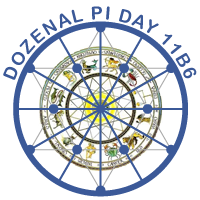The following is a short writeup I did for an event on Facebook celebrating Dozenal Pi Day on March 18, 11B6 (decimal March 20, 2010). As indicated in the text, it includes some borrowed material from the Wikipedia article on duodecimalism.
 I am not sure when exactly this "Pi Day" thing became so fashionable, but for me it has come to symbolize everything that is wrong and unwholesome about modern society's relationship with numbers. You see, of late I find myself more and more perturbed by the extent to which people seem to take the primacy of decimal notation for granted in conceptualizing and comparing numbers. In the case of pi, there is NOTHING particularly universal or ontologically significant in the sequence of digits 3.14159265... except that they represent a certain way of parsing the value of pi by successive fractions of ten. THIS IS MAY BE INTERESTING IF YOU ARE REALLY INTO THE NUMBER TEN FOR SOME REASON. Otherwise it—like the entire decimal radix system—is fairly useless.
I am not sure when exactly this "Pi Day" thing became so fashionable, but for me it has come to symbolize everything that is wrong and unwholesome about modern society's relationship with numbers. You see, of late I find myself more and more perturbed by the extent to which people seem to take the primacy of decimal notation for granted in conceptualizing and comparing numbers. In the case of pi, there is NOTHING particularly universal or ontologically significant in the sequence of digits 3.14159265... except that they represent a certain way of parsing the value of pi by successive fractions of ten. THIS IS MAY BE INTERESTING IF YOU ARE REALLY INTO THE NUMBER TEN FOR SOME REASON. Otherwise it—like the entire decimal radix system—is fairly useless.
HERE IS PI IN SOME OTHER RADICES to however many digits I feel like typing, using conventional alphabetic transdecimal notation where appropriate:
- Binary: 11.00100100001111
- Octal: 3.11037
- Hexadecimal: 3.243F
- DOZENAL or if you will duodecimal: 3.184809493B
For reasons I will get into shortly, the dozenal radix system is superior to decimal in almost every pertinent way, and should by all rights be adopted by human civilization as soon as possible, before it is too late. We are already far too entrenched in our decimalism, and will only become more so as time goes on and our technology continues to elaborate itself, and we dig ourselves in deeper with this "metric system" nonsense. If "Pi Day" is going to be mapped to our (conspicuously non-decimal) calendar according to some abstract system of positional notation, I would propose that this notation should at least be dozenal rather than decimal.
I have therefore invented "DOZENAL PI DAY" in recognition of this principle. (Though I would hasten to add that I've always found the idea of Pi Day to be somewhat silly anyway.) The goal of DOZENAL PI DAY shall be twofold: 1) to celebrate pi, as is traditional, and 2) to raise awareness of dozenalism/duodecimalism.
Now, as DOZENAL PI is 3.18..., it stands to reason that DOZENAL PI DAY should fall on the 18th of March. And as the 18th in dozenal is equal to the decimal 20th (decimal "12" being "10" in dozenal, plus 8), the day shall be celebrated on the conventionally-understood 20th of March, being actually the 18th of March, dozenally-speaking. That will be this coming Saturday. If that makes sense.
NOW A WORD ABOUT NOMENCLATURE: The base-12 numbering system is known as either duodecimal or dozenal. Both are probably acceptable. I, like many dozenal advocates, prefer the latter term since it does not legitimize decimalism by using decimalist Latin roots. "Duodecimal" means, obviously, 2 and 10 (or something like that), and that is a sort of awkward way of trying to express this system's superiority to decimal. But call it what you like.
ALSO: I am not a fan of writing dates in the "American" system of MM-DD-YY or -YYYY. Dates should be written either DD-MM-YYYY or YYYY-MM-DD, with the latter making a lot more sense, in terms of being able to sort data by their initial characters, et cetera. Putting this holiday in March is NOT an endorsement of the American system, it is done simply in recognition of the superiority of the YYYY-MM-DD system. Also because regular Pi Day was like yesterday and it's fresh in everyone's mind. So it works out well.
Anyway, DOZENAL PI DAY can and by all rights ought to be celebrated wherever you are, in whatever manner you see fit. People seem to enjoy eating pies on Pi Day, so that's probably a good idea. Indeed, as you may or may not have already vaguely realized, the term "dozen" is thrown around a lot in connection with bakeries and shit, and bakeries make pies, so there's presumably you know a lot of material to work with there. INVITE YOUR FRIENDS! It would amuse me if this event got like a ridiculous number of attendees by the weekend. Though I won't hold my breath.
Please also note that this Saturday is the vernal equinox, and that, generally speaking, Dozenal Pi Day shall fall on or around the equinox every year, which makes it even more interesting and worthy of festivity and merriment.
So: "Why," you may ask, "is dozenal so much better than decimal?" Well, I'm glad you asked:
Actually you know what I am just going to copy and paste some crap from Wikipedia here, since it is fairly well-written:
"The number 12 has six factors, which are 1, 2, 3, 4, 6, and 12, of which 2 and 3 are prime. The decimal system has only four factors, which are 1, 2, 5, and 10; of which 2 and 5 are prime. Vigesimal adds two factors to those of ten, namely 4 and 20, but no additional prime factor. Although twenty has 6 factors, 2 of them prime, similarly to twelve, it is also a much larger base (i.e., the digit set and the multiplication table are much larger) and prime factor 5, being less common in the prime factorization of numbers, is arguably less useful than prime factor 3. Binary has only two factors, 1 and 2, the latter being prime. Hexadecimal has five factors, adding 4, 8 and 16 to those of 2, but no additional prime. Trigesimal is the smallest system that has three different prime factors (all of the three smallest primes: 2, 3 and 5) and it has eight factors in total (1, 2, 3, 5, 6, 10, 15, and 30). Sexagesimal—which the ancient Sumerians and Babylonians among others actually used—adds the four convenient factors 4, 12, 20, and 60 to this but no new prime factors.
"As explained in recurring decimals, whenever an irreducible fraction is written in radix point notation in any base, the fraction can be expressed exactly (terminates) if and only if all the prime factors of its denominator are also prime factors of the base. Thus, in base-ten (= 2×5) system, fractions whose denominators are made up solely of multiples of 2 and 5 terminate: 1?8 = 1?(2×2×2), 1?20 = 1?(2×2×5), and 1?500 = 1?(2×2×5×5×5) can be expressed exactly as 0.125, 0.05, and 0.002 respectively. 1?3 and 1?7, however, recur (0.333... and 0.142857142857...). In the duodecimal (= 2×2×3) system, 1?8 is exact; 1?20 and 1?500 recur because they include 5 as a factor; 1?3 is exact; and 1?7 recurs, just as it does in decimal.
"Arguably, factors of 3 are more commonly encountered in real-life division problems than factors of 5 (or would be, were it not for the decimal system having influenced most cultures). Thus, in practical applications, the nuisance of recurring decimals is encountered less often when duodecimal notation is used. Advocates of duodecimal systems argue that this is particularly true of financial calculations, in which the twelve months of the year often enter into calculations.
"However, when recurring fractions do occur in duodecimal notation, they are less likely to have a very short period than in decimal notation, because 12 (twelve) is between two prime numbers, 11 (eleven) and 13 (thirteen), whereas ten is adjacent to composite number 9. Nonetheless, having a shorter or longer period doesn't help the main inconvenience that one does not get a finite representation for such fractions in the given base (so rounding, which introduces inexactitude, is necessary to handle them in calculations), and overall one is more likely to have to deal with infinite recurring digits when fractions are expressed in decimal than in duodecimal, because one out of every three consecutive numbers contains the prime factor 3 in its factorization, while only one out of every five contains the prime factor 5. All other prime factors, except 2, are not shared by either ten or twelve, so they do not influence the relative likeliness of encountering recurring digits (any irreducible fraction that contains any of these other factors in its denominator will recur in either base). Also, the prime factor 2 appears twice in the factorization of twelve, while only once in the factorization of ten; which means that most fractions whose denominators are powers of two will have a shorter, more convenient terminating representation in dozenal than in decimal (e.g., 1/(22) = 0.25 dec = 0.3 doz; 1/(23) = 0.125 dec = 0.16 doz; 1/(24) = 0.0625 dec = 0.09 doz; 1/(25) = 0.03125 dec = 0.046 doz; etc.)."
Thank you for your attention, and for some inexplicable reason apparently reading this entire diatribe, and have a happy Dozenal Pi Day 11B6.
 Dozenal Pi Day 11B6
Dozenal Pi Day 11B6